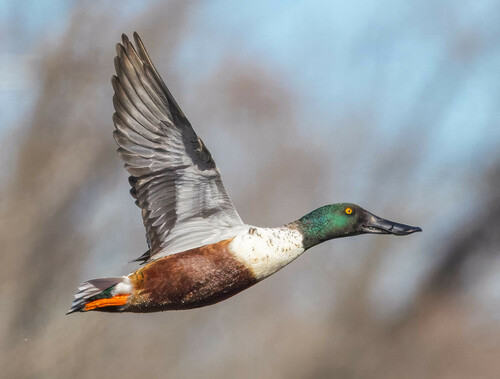
Northern Shoveler
The Northern Shoveler (Spatula clypeata) is a widespread dabbling duck known for its distinctive, spoon-shaped bill. This unique adaptation is used to filter food from the water, making it a highly specialized feeder. It plays a crucial role in wetland ecosystems by consuming small invertebrates and plant matter, helping to regulate populations and cycle nutrients. While not generally considered a bird of significant cultural importance, its distinctive appearance makes it easily recognizable and appreciated by birdwatchers.
43-53 cm
Length
70-85 cm
Wingspan
Least Concern
Conservation Status
Distribution
Breeds across North America, Europe, and Asia. Migratory, wintering in the southern United States, Mexico, Central America, northern South America, sub-Saharan Africa, the Indian Subcontinent, and Southeast Asia. Altitudinal range varies from sea level to higher elevations in some regions, depending on suitable wetland availability.
Lifespan
Average lifespan in the wild is 3-5 years, but some individuals can live longer. Captive birds may live for over a decade.
Northern Shoveler's Habitat
Habitat Types
Freshwater marshes, Shallow lakes, Ponds, Flooded fields, Coastal lagoons, Estuaries
Climate Zones
Temperate, Boreal, Subtropical, Tropical
Adaptations
The Northern Shoveler's specialized bill, with fine lamellae (comb-like structures), allows it to efficiently filter small food items from the water. They are also adapted to a variety of water salinities, thriving in both freshwater and brackish environments.
Variations
No widely recognized subspecies, though slight variations in size and plumage coloration may occur across its vast range. These differences are generally considered clinal rather than distinct enough to warrant subspecific designation.
Appearance
Breeding Plumage
Breeding males have an iridescent green head, white breast, chestnut belly and flanks, and a black rear. Females are mottled brown year-round. Non-breeding males (eclipse plumage) resemble females but retain some wing pattern characteristics.
Seasonal Feather Changes
Males undergo a complete molt after breeding, adopting the eclipse plumage. Females have less dramatic seasonal changes, maintaining their cryptic brown coloration.
Sex Based Plumage Differences
Strong sexual dimorphism is present, particularly in breeding plumage. Males are brightly colored, while females are camouflaged brown.
Notable Features
Large, spatulate bill, Bright yellow or orange eyes (adults), Orange legs and feet
Diet and Feeding
Primary Foods
Small crustaceans, Zooplankton, Aquatic insect larvae, Mollusks, Seeds, Aquatic plant matter
Foraging Behavior
Northern Shovelers feed by dabbling, swimming with their heads submerged and bills skimming the water surface or slightly below. They often swim in tight circles to stir up food. Groups may feed cooperatively.
Specializations
The large, spatulate bill with numerous lamellae acts as a sieve, allowing the bird to strain small food items from the water with high efficiency.
Seasonal Diet Variations
Diet can vary seasonally depending on food availability. During breeding season, they may consume more invertebrates, while seeds and plant matter may become more important in winter.
Behavior
Social Structure
Generally gregarious, especially outside of the breeding season. Forms large flocks during migration and on wintering grounds. Breeding pairs are territorial.
Communication
Low quacks (females), Nasal calls (males), Visual displays (head movements, wing flapping)
Migration
Long-distance migrant. Northern populations undertake extensive migrations to southern wintering areas. Migration routes are often along coastlines or major river systems. Migrates in flocks, often at night.
Territorial or Group Behaviors
During the breeding season, males defend territories around the nest site. Outside of breeding, they are highly social and form large flocks, sometimes numbering in the thousands.
Conservation
Threats
Habitat loss and degradation (wetland drainage), Pollution (pesticides, heavy metals), Climate change (altered precipitation patterns, sea-level rise), Hunting (in some regions)
Protection Programs
Migratory Bird Treaty Act (US and Canada), Agreement on the Conservation of African-Eurasian Migratory Waterbirds (AEWA), Wetland conservation initiatives (Ramsar Convention)
Local National Laws
Protected under various national and international laws regulating hunting and habitat protection.
Population Trend
Stable
Population Estimates
Global population estimated to be several million individuals.
Interesting Facts
Their bill contains about 110 lamellae on each side.
These comb-like structures help filter out tiny food items.
They sometimes steal food from other ducks.
This behavior, known as kleptoparasitism, is observed occasionally.
They can swim with their bills fully submerged.
This allows continuous feeding while moving.
Faqs about Northern Shoveler
What is the purpose of the Northern Shoveler's large bill?
The large, spoon-shaped bill is used for filtering small invertebrates, seeds, and other food items from the water.
Are Northern Shovelers good to eat?
While they are hunted in some areas, their diet of invertebrates can sometimes give their meat a less desirable flavor compared to other ducks.
Where can I see Northern Shovelers?
They can be found in wetlands, marshes, and shallow lakes across North America, Europe, and Asia during the breeding season, and in similar habitats in their wintering ranges.
Do both the male and female Northern Shoveler build the nest?
No, only the female Northern Shoveler builds the nest. It's typically a shallow depression on the ground, lined with grasses, down feathers, and plant stems.
How do Northern Shovelers find their food?
Northern Shovelers use their specialized bills to sift through water and mud. They often swim in circles, creating a vortex that brings food particles to the surface, which they then filter out.
Copyright @ Nature Style Limited. All Rights Reserved.
 English
English